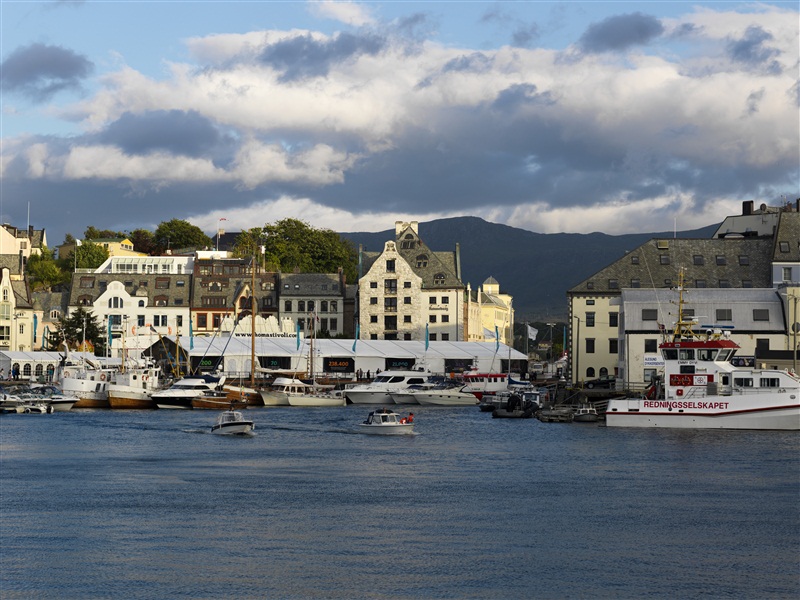On her first Arctic sailing trip, commercial skipper JoJo Pickering is wowed by the mountains, deep anchorages, fjords, and endless daylight of Norway’s west coast.
My first time going above the Arctic Circle for some Arctic sailing required a few adjustments to the usual packing list.
Trying on my brand-new oilskins, I belatedly realised that they were not big enough for me to wear additional warm layers underneath. It was the beginning of May, there was still snow on the ground and it was cold.
I had flown to Svolvær, in the Lofoten Islands, the day before and I was about to skipper Isbjørn, a beautiful 48ft Swan, south towards Bergen via Flam at the end of the longest fjord in Norway.
I went to the local fisherman’s shop and bought myself an all-in-one insulated waterproof suit to wear over my oilskins.
The temperature was around 4°C during the day, colder at night and even colder with the wind chill factor. It did the job, it kept me warm.
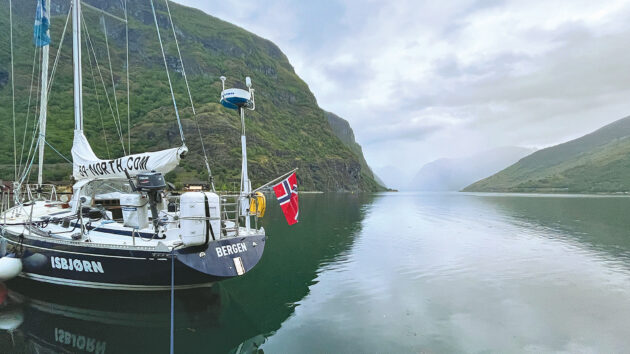
The 48ft Swan Isbjøn moored in Flåm. Photo: JoJo Pickering.
I had three days to prepare the boat, provision and be ready to welcome the crew – it’s always a great moment when the crew arrive, excited about the trip and keen to get to know their fellow sailors.
We were six in total on this Arctic sailing cruise, and a 50:50 split of women and men. One of the great things about skippering for 59° North Sailing is its commitment to women sailors.
Vital preparations for Arctic sailing
Traditionally, we spend the first day on domestic briefs, deck walk and crew familiarisation, followed by a supper ashore.
The second day is filled with in-depth safety briefs where we talk through different scenarios to minimise the likelihood of potential accidents at sea and what our responses could be. We aim to be prepared, not scared.
Finally, we were ready for our Arctic sailing adventure, but the weather was not!
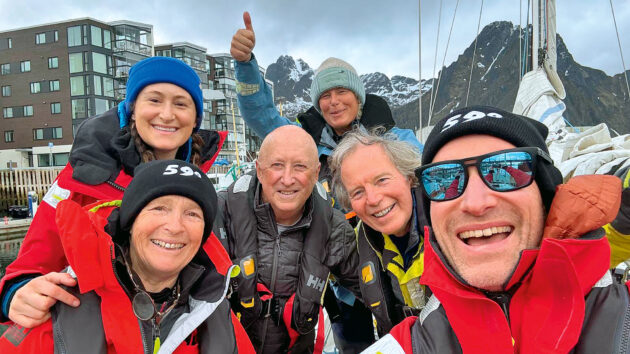
Skipper and crew ready to depart after all the safety briefings. Photo: JoJo Pickering.
That evening a gale was howling as we did our passage planning, and cold sleet battered the crew as they ventured out to the toilets ashore.
The wind was forecast to ease, but we knew it would be creating big swells with short wave lengths, so we planned to sail to Bodø, protected by the Lofoten Wall, the amazing line of mountains jutting out from Norway.
The first passage on our Arctic sailing trip
We departed Svolvær – bound for Bodø – the next morning under grey skies with a gentle north-westerly, which increased as we came outside the wind shadow of the mountains.
I was loving being back at sea, and excited to be finally doing some Arctic sailing.
As we sailed briskly on a reach across the bay, the cloud cover lifted and for the first time, we could see the Lofoten mountains and the mountains of the mainland. Wow, they were amazing!
After the general excitement of departure, everyone took the opportunity to go below into the warmth. The first watch had got quite cold.
We all learned from that. This coast is so beautiful, the temptation is to stay outside longer to enjoy the amazing views, but the north-westerly wind was cold.

At anchor in Kjelbotn, north-east of Landegode –anchorages are hard to find as the water is so deep. Photo: JoJo Pickering.
As we rounded Landegode island (800m high) and headed south towards Bodø, the sun went behind the mountains.
Suddenly, the temperature plummeted, the wind backed to the south and now we had headwinds. This had been forecast, but we’d hoped to reach Bodø first.
Checking our chart, we saw there was an anchorage at the north-easterly end of the island. So we made our way into Kjelbotn, a beautiful, deserted anchorage, and dropped the hook in 7m with a mud bottom.
Local particulars
It is not always easy to anchor in Norway, as the water is often too deep and the holding poor.
Still, there are some magical places and it is always so peaceful.
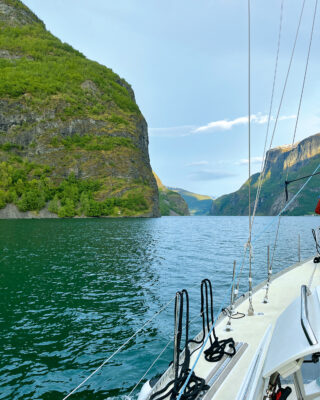
It’s often deep close to the fjord cliffs. Photo: JoJo Pickering.
We had a quiet night with some gusty conditions as the wind rolled down the mountain, then we woke up to a stunning view of our anchorage – a few fisherman’s huts, a few sheep, but mostly beautiful Norwegian hills.
After a hearty breakfast of scrambled eggs we prepared to haul up the anchor, and what a haul it was!
It required some careful back and forth with the engine to break the anchor free. Lots of seaweed came up, too, but we got it cleared and headed out.
The great thing about sailing in Norway is that you have the choice to sail offshore along the coast, outside all the tiny islands and skerries, or through the inland route, winding your way through the islands and fjords.
As there was little wind, we motor-sailed for the first few hours taking the inside route through the spectacular landscape.
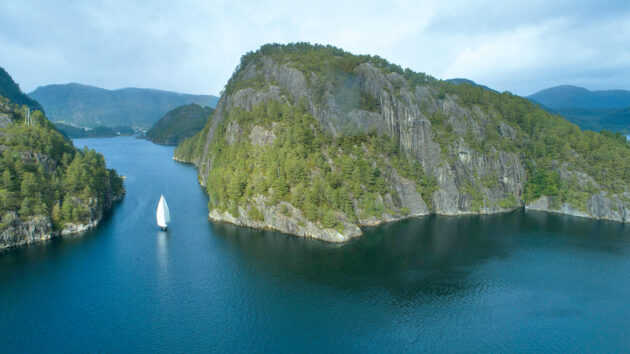
The Swan 48 Isbjørn dwarfed by Norwegian fjords. Photo: James Austrums.
Then the wind filled in and we had an exhilarating fast sail on a broad reach in the flat, protected waters of the inner route winding our way south.
At that time of the year above the Arctic Circle it doesn’t get dark, so you don’t have to think about arriving in port in daylight hours. We decided to keep sailing south into the evening and stop at about midnight.
What a beautiful sail we had, with the sun slowly setting behind us. As we headed into dusk, the wind eased and we motor-sailed the last few miles, crossing the Arctic Circle and making port at Tonnes shortly afterwards.
Fortunate fix
The next morning, on my daily engine check, I found that the alternator tensioning bar was broken. I don’t know when this had happened, but it was a significant issue.
We have a large bank of lithium batteries on Isbjørn, so I was not concerned about managing power, but the belt of the alternator runs the water pump which cools the engine. If the belt stops turning the water pump, the engine will overheat.
I informed our shore support of the situation and briefed the crew. At first it seemed that a fix would be unlikely in this out-of-the-way place.
Amazingly, a local retired mechanic, named Knut, was kind enough to weld the broken bracket – a temporary repair.
This was great news and highlights a wonderful aspect of comradeship and support of fellow sailors in Norway.
The delay meant the crew had a lovely hike and showers, and the mist and rain lifted before we departed.
There was no room to turn under power, and Isbjørn was pointing 180° in the wrong direction, so we decided to warp her around.
We prepared the mooring lines and Isbjørn slowly and majestically turned, helped by the wind and careful management of ropes.
As we motored south, with little wind, the alternator belt was still squeaking.
We discussed what we would do if the engine failed. We had the full main up, we made sure the anchor was ready for quick deployment, we kept to the windward (safe) side of the channel, and regularly monitored the engine temperature and alternator belt.
Rounding a challenging headland
The Statt Peninsula (sometimes called the fist) sticks out into the Norwegian Sea and is famous for being a dangerous and difficult headland to round.
It also marks the delineation between the north and south Norwegian cruising grounds, and is a useful reference point when Arctic sailing.
The weather forecast was for very little wind followed by a strong northerly, building to a gale.
We talked it through and decided to keep pushing south, keeping to the inside route first, then heading offshore as the wind veered in our favour.
The near endless daylight made night watches eerie and memorable.
It was so striking to see sunrise so quickly follow sunset with the light never leaving the sky.

The arctic sunset lasts hours. Photo: JoJo Pickering.
As we headed south there was suddenly a big change in landscape. We left the high mountains behind and this was replaced by a flatter, greener landscape and trees! It was great to see the trees.
We settled into our watches with cooking, pilotage and good company.
One evening in misty twilight, with the water glassy, we watched in awe as a pod of minke whales swam past us. We all felt lucky and privileged to be out there, feeling insignificant and joyful.
The sun rose, bringing with it the wind. We had a beautiful, magical sail as we made our way offshore.
The wind veered as forecast, we reefed the main, the swells built, and we thundered south on a broad reach doing 8.5 knots. An exhilarating sail.
The crew had to adjust to moving safely around the boat, clipping-on when on deck, and the challenges of putting on ‘foulies’.
Nightfall
We headed south as the night became darker under overcast skies as a weak front came over.
As we got close to the Statt the wind decreased to nothing and fog descended. We started the iron topsail, put the radar on, made sure the foghorn was ready and carefully nosed our way closer to the headland.
As I’d hoped, as we got closer to the Statt, the mist lifted and there, laid out before us, was this majestic headland.
We could understand why this area could be nasty. The depths were not stable, and you could see the currents swirling.
As we made our way back into the inside route, the wind increased and we had another glorious sail towards Maløy. We were exhausted but happy.
The following day we departed Maløy with just the genoa and started weaving our way through the fjords. What a great day of pilotage and sailing at 8 knots under genoa alone in strong winds.
We arrived in beautiful Florø at dusk and decided to spend the day in port to allow the next gale to come through.
Exploring fjords while Arctic sailing
When sailing in the fjords and around high islands, the winds can be unpredictable, with acceleration zones and wind shadows.
When we departed Florø and headed towards Laberget at the mouth of the Sognefjorden, we were expecting strong northerly winds.
With two reefs in the main and alternating between full and reefed genoa, we kept a sharp look out on the water ahead for squalls.
We had some exciting and gusty sailing. What an amazing place Norway is to cruise. We couldn’t stop taking photos.
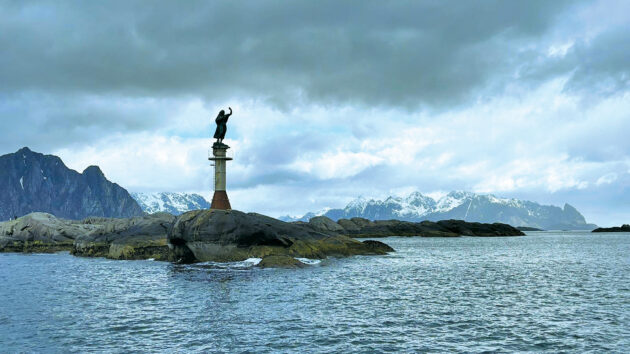
The Fisherman’s Wife at the entrance to Svolvær. Photo: JoJo Pickering.
We were headed first towards Laberget, which is at the entrance to the Sognefjorden, Norway’s longest Fjord with depths of over 1,600m.
Then we sailed up the Sognefjorden towards Flåm. We inevitably had gusty headwinds to start which then died to nothing, so we motored most of the remaining distance.
It was a beautiful warm, sunny day, perfect for enjoying the many hillside villages and farms dotted between forests and sheer drops into the deep fjord.
We rounded one corner and suddenly it got much colder.
We could see the glacier high up in the distance. As we continued on our journey, the fjord got narrower and it felt there was no way through, until we got closer, rounded a corner and Flåm, our destination, came into sight.
A year ago, when I agreed to skipper this trip, I thought I’d get to know Norway.
It would take a lifetime to explore the many islands, skerries, fjords and countless beautiful anchorages, but I have learned loads, particularly that Norway is a beautiful country, well worth the effort to go North to experience the unique beauty of Arctic sailing.
Norwegians have a long heritage of maritime history going back to the Vikings, who were extraordinary navigators. They are proud of their beautiful country and incredibly welcoming. Most people speak some English and are pleased to help in any way.
Give yourself plenty of time to cruise Norway and explore. As in most popular sailing destinations, July and August are very busy months when many people take to the water.
Polar night and midnight sun
The Arctic Circle is one of the two polar circles.
At roughly 66° 34’ N, its latitude is not fixed, but depends on the earth’s axial tilt, which fluctuates within a margin of more than 2° over a 41,000-year period, owing to tidal forces resulting from the orbit of the moon. Its current position is 66° 33’ 41.800” north of the Equator.
The Arctic Circle marks the southernmost latitude at which, on the winter solstice in the northern hemisphere, the sun will not rise all day, and on the northern hemisphere’s summer solstice, the sun will not set.
These phenomena are referred to as polar night and midnight sun respectively, and the further north you progress, the more pronounced these effects become.
There is no better way to experience their magical effect than while Arctic sailing.
Arctic sailing tips from a professional skipper
Getting fuel
It is not always obvious from charts and pilot books where the fuel docks are. We needed to fuel up in Maløy, in the region of Kinn, Vestland, and the pilot book said there were four fuel stations, but did not indicate where.
We motored around for about half an hour trying to find them. We could see one small fuel pontoon, but that was far too small for us. We eventually found the correct dock; we had similar experiences in other places.
Many bridges
It’s very important to know your accurate air draught when cruising in Norway.
Many bridges do not show the clearance, so you need to find the accurate information from your chart. At one bridge that looked especially low, we took our time to be triple sure we could pass under.
Shore facilities
In many places there are excellent shore facilities.
In Florø, and also in Kinn, there were showers and toilets, washing machines and dryers (free), plus a common room with books and tables and chairs.
Summer weather
The prevailing wind is south-westerly on the south coast in summer and north-westerly on the western and northern coasts. There are often high-pressure systems with prolonged periods of no wind.
Summer gales are also not unusual, but on the plus side there are plenty of safe places to take shelter.
Internet
We found there to be excellent 4G coverage throughout Norway.
Recommended websites include: Kartverket.no.
The Norwegian Mapping Authority provides geographical information for both land and sea, including tidal information, charts and much more.
Norwegiancruisingguide.com Print or eBook in five volumes.
Essential navigational aids and apps for Arctic sailing
The best pilot book in English is Norway by Judy Lomax, published by Imray. Also consider:
GoMarina: This app is used by most marinas in Norway to pay for your mooring and services. It is easy to sign in to make an account.
Harbour guide: This great app provides detailed, up-to-date harbour information including anchorages. It is in Norwegian, but provides an option to auto translate. A photo and sketch chart of every location is included with pilotage information. I would not be without a subscription to this app.
YR.no: Norway weather app.
Formalities
Norway is a Schengen country, so you need to check-in if you are coming from a non-Schengen country like the UK.
Passports must be stamped on arrival and departure. Check which are the ports of entry, and ensure documents are up to date before departing.
Rescue service
The Norwegian Sea Rescue Society is a membership organisation dedicated to assisting sailors and vessels at sea.
Membership includes three free call-outs per year. They can help you mend your engine and have divers who can help with fouled propellers.
JoJo Pickering is a professional freelance skipper, an RYA Yachtmaster Instructor and RYA Theory Instructor, including OCean. She is currently working for 59° North Sailing. JoJo has skippered vessels from Clipper 60s to 100-year-old Bristol Channel Pilot Cutters. She owns a 35ft Wylo, a steel Gaff Cutter called Island Swift, and is committed to supporting other women sailors.
Marina Guedes sails into the Arctic Circle and discovers the timeless beauty of Norway’s west coast and Lofoten Islands
Scandinavian country amends its tax laws
Want to read more articles on cruising Norway and the Arctic?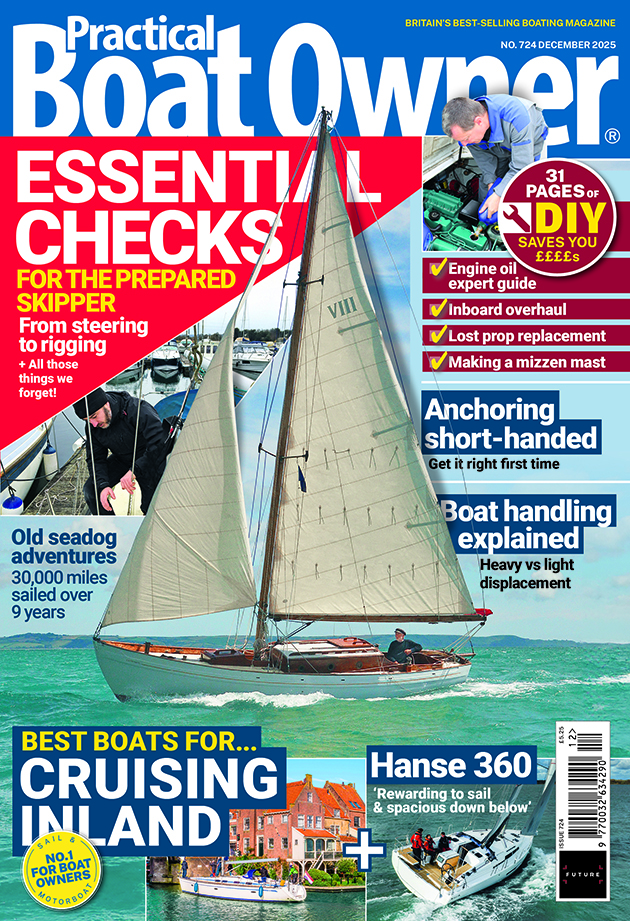
A subscription to Practical Boat Owner magazine costs around 40% less than the cover price.
Print and digital editions are available through Magazines Direct – where you can also find the latest deals.
PBO is packed with information to help you get the most from boat ownership – whether sail or power.
Take your DIY skills to the next level with trusted advice on boat maintenance and repairs
Impartial, in-depth gear reviews
Practical cruising tips for making the most of your time afloat
Follow us on Facebook, Instagram, TikTok and Twitter


